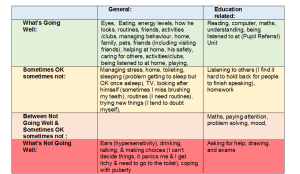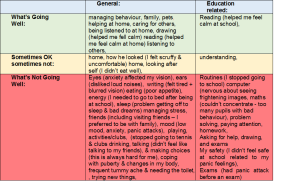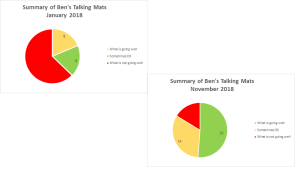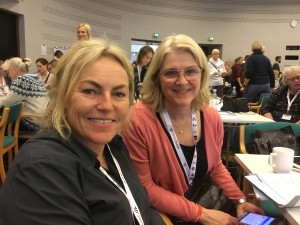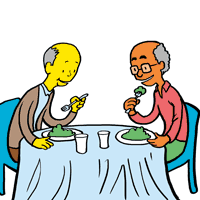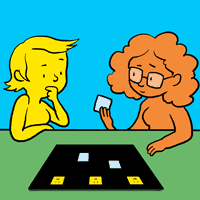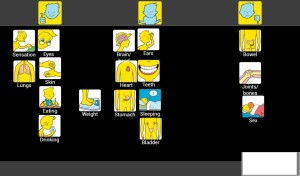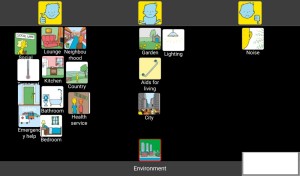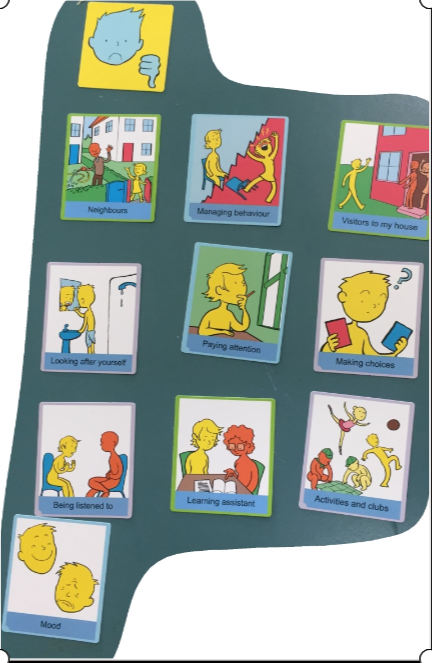Many thanks to Tina Wood, Occupational Therapist at Therapy In Motion, for this great example of how Talking Mats can be used to explore thoughts and feelings both in present-day and in retrospect, to evidence positive outcomes from a change in educational placement. Tina’s use of colour coding and pie charts really helps to illustrate this.
Tina attended our Talking Mats Foundation training back in September 2016 and since then she has been using Talking Mats regularly in her work as an Independent Occupational Therapist.
In this example, Tina has used Talking Mats to enable Ben (name changed for anonymity, age 12½ years) to share his thoughts and feelings using the Talking Mats ‘Consulting Children and Young People’ resource packs – focusing on the topics ‘My Body and Skills’ and ‘What I do and Support’.
At the time of this Talking Mat, Ben had been accessing a new placement at a Pupil Referral Unit for the past 11 months (click on the picture below to see a clearer version).
As there was clearly a difference in how Ben felt things were going when he was attending his previous school, Tina decided to ask him to do a retrospective Talking Mat of how things were going for him 11 months ago in January 2018, when he started to feel “unwell”.
This enabled comparison with how he feels now in the “safe setting” of the Pupil Referral unit (click on picture to see a clearer version).
Tina then compiled the information from the above tables into pie charts, enabling a clear visual comparison between the two times/situations (click on picture to see a clearer version):
As can be seen from these charts, there had been a huge change in Ben’s perception of how he is coping with life in general and school in particular.
Tina recommended that this information needs to be considered along with the rest of Ben’s sensory needs (as reported in her full OT report) when deciding on what is the best educational setting for him after leaving the pupil referral unit.
We love this use of colour coding and pie charts to illustrate the information from Ben’s Talking Mats – to really ensure that Ben’s feelings and thoughts are seen and heard.
If you would like to know more about accessing Talking Mats training – available across the UK and Ireland as well as online – please take a look here: https://www.talkingmats.com/training/
If you have any examples of how you report/share information about completed Talking Mats we would be interested to hear about it! Just email laura@talkingmats.com
In this latest blog, our Director, Lois Cameron describes the initial stage of a Scottish Learning Disabilities Observatory project aimed at enabling involvement and engagement of people with learning disabilities in supporting people with learning disabilities to have a voice. A great example of co-production in action:
Background
The Scottish Learning Disabilities Observatory aims to generate evidence, build understanding and provide information on the causes of poor health and health inequalities experienced by people with learning disabilities in Scotland. However, they recognised that there was a need to develop their approach to involving people with learning disabilities. They considered whether a citizens’ jury for people with learning disabilities on health and health research would be a constructive way of engaging people with learning disabilities in supporting people with learning disabilities to have a voice. From the outset, they acknowledged that communication would be a key challenge and approached Talking Mats to work with them to put forward a bid to the Welcome Trust Public engagement fund. This bid was written, submitted and was successful.
To establish the project, our first task was to recruit a Public Engagement Lead to take the lead on project delivery. This raised the first hurdle, as since the Engagement Lead was not in post there was no citizen’s jury and therefore no pool of people with learning disabilities to approach to be involved in the interview panel. From the outset, involvement of people with learning disability was seen as central to the project. Talking Mats had recently completed a course working with people with learning disabilities from the National Involvement Network to become Talking Mats interviewers, so we approached one of the participants who had completed the course and asked if he would be willing to be on the interview panel. He was very happy to take part and contribute his skills and experience to the interview panel.
Planning the interview Talking Mat
We examined the job description and divided it into questions that were more factual and knowledge-based and those that we might describe as ‘softer’. However, calling them soft might be misleading as they were actually value based and we felt that the successful candidate’s proficiency and self-awareness in responding to these options would be central to the success of the project. After going through this sifting process we came up with 8 possible options for the interview talking mat. We met with our interviewer from the National Involvement Network and with him honed it down to six and choose the top scale: extremely confident, confident, not that confident. He also choose the symbols he wanted to use. Candidates would be asked to justify where they placed their options. A script was developed to support the interviewer e.g. ‘It would be good if when you placed the card down you gave us a reason why you placed it there. Examples from other work you have done would be helpful’ . The full script can be found here – Interview Script
The six options were:
- Making information accessible
- Making sure everyone has a chance to speak
- Helping the group understand research
- Helping the group set its goals
- Involving people with severe learning disabilities in the research agenda
- Not taking power away from the group
The interview
In the interview, candidates were asked to give a short presentation, and then the member of the National Involvement Network carried out the Talking Mat. After this, there were some further panel questions and a chance for the candidate to ask questions.
The experience and outcomes
“I really liked being involved in making the mat. At the interview I knew what I had to do and I felt the other interviewers listened to me and my opinion.”
Other panel member’s perspective
“Having never used a Talking Mat in a recruitment interview before I was not sure how effective it would be as a recruitment tool. We wanted the process to be as inclusive as possible, where all interviewers had a clear and purposeful role. The Talking Mat worked really well, both as a way of gathering knowledge and information from the candidates, but also by providing an opportunity to observe the interactions between the candidate and the interviewer. I also think that the structured framework of the Talking Mat put the interviewer at ease and it was nice to observe that his confidence in using it in this context and, where necessary, in prompting and supporting the interviewee. All in all this was an effective way of conducting an inclusive interview process that signalled to our candidates that people with learning disabilities should be involved meaningfully in all stages of the process. It also meant that when we came to reviewing the candidates against the role criteria all members of the panel were able to contribute. I can’t wait to do more interviews like this!”
Candidate perspective:
“For me, an interview process is really about making sure that you and your potential new employer have compatible values. Therefore, it was a relief to have someone with learning disabilities on the interview panel who could help direct the questions. It was also clear that the interviewer knew how he fit into the interview process and was taking the lead on his section of the interview.
The Talking Mat itself was an interesting tool for the interview discussion because the top scale allowed me to look at where my skills and confidence were but also identify some potential challenges within the project. The interviewer also really kept me on my toes with some good follow up questions. In one in particular, he asked me what I would do if he was talking too much and dominating the conversation in the group. It was a challenging question and quite uncomfortable on the spot, but it forced me to be honest about my own values and say that actually, the right thing to do is to politely confront someone who is not letting others speak.
The benefit of a Talking Mat is that it has to be really clear and concrete to work, so I actually felt that I understood the demands of the role better than reading the much longer job description.”
Summary
The involvement of people with learning disabilities was possible from the start of the project because we were able to harness the skills and experience of a person from the National Involvement Network who was trained in Talking Mats. He had a clear independent role which was central to the interview process and improved the quality of the information gained by panel members . The Talking Mats design gave all panel members particular insight into those ‘soft skills’ that were felt to be crucial to the project and that might not have come through so clearly if just the traditional presentation and questions were used.
If you are thinking about a Talking Mats project for your own organisation/service you can find more information here: https://www.talkingmats.com/projects/
Rachel Woolcomb, our Talking Mats OT Associate, tells us about the recent Royal College of Occupational Therapists’ Report and considers the ways Talking Mats can support:
The Royal College of Occupational Therapists have recently published a new report. “Making personalised care a reality: The role of occupational therapy.”
As the OT Associate for Talking Mats, I took the opportunity to review the document and consider how Talking Mats can help OT’s in fulfilling the recommendations made.
The report recognises that people living with long-term conditions bring different and equally important, knowledge and expertise to the decision –making process.
It challenges OT’s to ensure that they really listen to, and hear the views of the people they work with.
A Talking Mat can help facilitate this. It helps people to understand what is being discussed, to reflect and organise their thoughts, to say what matters most to them and record their views. It helps OT’s to really listen, to learn new information, to involve the person in their own planning and support decision making.
Read more about how Talking Mats can help OT’s to make personalised care a reality in the TMOT Resource 1: TM Personalised Care – Copy.
The RCOT report is available here: https://www.rcot.co.uk/news/delivering-personalised-care-frontline
Rachel would love to hear from you if you have any examples of how Talking Mats have helped you to provide personalised care, or if you want to know more about OT and Talking Mats. Her email is: Rachel@talkingmats.com.
If you are feeling inspired and would like to find out about accessing Talking Mats Foundation Training, take a look at our upcoming courses across the UK, as well as online and organisational training options: https://www.talkingmats.com/training/
This blog is about how Care Inspectors in Sweden are using Talking Mats.
On 18th March I met up with old friends – Ulrika Ferm and Eva Holmqvist – at the ISAAC Denmark Conference in the beautiful Vingsted Conference Centre in West Denmark. Ulrika and Eva work at DART Communication Centre in Gothenburg Sweden http://www.dart-gbg.org/english/.
I was giving a presentation on new developments in Talking Mats and as always happens when we meet, we talked non stop about families and work.
Ulrika told me about the following initiative in Sweden and we agreed it would be useful to write a blog about it.
The Health and Social Care Inspectorate https://www.ivo.se/ (the Swedish equivalent of the Care Commission) had been in touch with DART about how they could get the views of people with dementia who live in care homes.
DART made a program of communication for the inspectors which included a first day about communication and dementia. Following this there was a full 2 day course on Talking Mats for 15 inspectors who then went on to pilot the use of Talking Mats as a way to get the genuine views of residents. It was so successful that they are planning to roll this out elsewhere. Now more inspectors in Sweden are getting Talking Mats training and using pictorial support as preparations before inspections.
It would be really good if this could happen in Scotland.
Many thanks to Mary Walsh, Health Service Executive (HSE) Senior SLT at St Mary’s Hospital, Dublin for this fantastic blog post about their project involving use of Talking Mats to support people with Dementia to participate in decision making related to their needs:
In September 2016 Aideen Lawlor (SLT Manager) and I (Senior SLT) won the Dementia Elevator award with a project entitled “Empowering Persons with Dementia to become more Active Participants in Decision Making Related to Their Present and Future Needs.” with Talking Mats being an integral part of this project. In November 2017, the prize money was used to fund my training to become an accredited Talking Mats trainer so that I could then train others in TM Foundation Course on a prioritised basis.
This project is now complete with 6 speech and language therapists (SLTs) from a variety of settings working with persons with dementia all trained in using Talking Mats. As part of their training, The SLTs used TM with patients/ residents with particular reference to the Assisted Decision Making (Capacity) Act 2015. TMs were also used to help the clinicians to get to know their patients, in care planning, in improving increased opportunities for interaction and in improving choices and decision making. In effect, we were checking it out!
All the SLTs found that when TM principles are followed, that it helped to empower people with dementia to make decisions about their care. Some of the reported findings:
- That the pictures help maintain attention and aid comprehension.
- That it facilitated strengths rather than a deficit model.
- That photographed completed TM provided a pictorial record for meetings – very positive.
- That it provided a significant catalyst for change in some instances.
- That it helped people with dementia and responsive behaviour get needs met
- That video recording sessions with consent greatly enhances reflective practice and may be helpful in key decision making
The next phase is to expand the number of SLTs who can provide training in Talking Mats across the Republic of Ireland. Funding from the national SLT professional body training grant scheme has been sought for these 6 SLTs to become trainers for Talking Mats. This will result in cascading training on a priority basis, increase evidence base/ knowledge re using TM and embedding TM in variety of clinical settings with SLTs leading this practice.
Mary Walsh,
Senior speech and language therapist,
St. Mary’s Hospital,
Phoenix Park, Dublin 20,
Ireland
Aideen Lawlor
Speech and Language Therapy Manager
If you are feeling inspired and are interested in accessing Talking Mats training, we offer Foundation Training courses throughout the UK and Ireland as well as online – take a look here for more details:
Once you have accessed Foundation Training you can apply for our Accredited Trainers course to enable you to deliver Talking Mats training to others in your area.
We are delighted to introduce Rachel Woolcomb our first Talking Mats OT Associate. She is joining the Talking Mats Team and will be working to develop awareness and use of Talking Mats by Occupational Therapists. I will let Rachel introduce herself:
I am delighted that Talking Mats have asked me to join their team for one day a week. I am passionate about occupational therapy and about Talking Mats and to have the opportunity to bring these two loves together and seeing what develops is very exciting.
I live in South Gloucestershire and have had a varied career since I qualified as an Occupational Therapist in 1992. I was introduced to Talking Mats in 2008 and have never looked back, using them with my clients ever since.
In 2017, having spent over 25 years working in the NHS, I made the decision to move into independent practice. I work predominately with teenagers and adults who live with long term neurological conditions or who have experienced catastrophic injuries following trauma. I am very aware of the psychological impact of sudden disability and the need for people to be able to express who they are and what is important to them, even in difficult circumstances.
I now use Talking Mats with most of my clients. It doesn’t matter if they are old or young, can speak or have communication needs, they all benefit from the opportunity to stop and think and have someone really listen to them.
In the last few weeks a man who has had a stroke and has limited expressive speech has used a Talking Mat to talk about what leisure activities he used to enjoy. He then used a second mat to explain what he can and cannot achieve now. This helped us together, set goals for occupational therapy. I am also working with a teenager who has had a traumatic brain injury and now struggles with her education. She uses Talking Mats with me regularly, to think about her coping skills at school. Looking back at her previous mats is helping her to recognise progress. I have so many more examples and will be sharing them with you soon!
I really want to inspire OT’s, helping them to consider how they enable their clients to think, communicate their choices and make decisions. A Talking Mat is a great for this. It is also creative and interactive something that in my experience OT’s like! I will also be looking at important issues within the field of occupational therapy that are currently driving practice, such as personalised care, goal setting and shared decision making. I believe it is vitally important that we collaborate with our clients as together we can achieve so much more. Talking Mats is an effective tool in enabling this, so watch this space, and please do get in touch if you want to know more or have stories to share.
It is great to have Rachel working with us to build on some of the excellent work being done already in the Occupational Therapy Sector. Our Director, Lois Cameron shares why we are so excited to welcome Rachel to our Team:
‘I am really pleased that Rachel is joining us . I think the Talking Mats approach sits well with the values and approach of Occupational therapy, In my experience OTs are naturally holistic in their approach. I remember at a training course in London an OT said for her Talking Mats was the missing link in her toolkit. The training and experience of OTs allow them to see things through a different lens and that will be really helpful to us’
For more information about how OT and Talking Mats are a winning combination, take a look at Rachel’s recent blog – https://www.talkingmats.com/talking-mats-and-ot-a-winning-combination/
Feeling inspired and want to know more about the training courses we offer? See www.talkingmats.com/training/ for details.
In Stockport we have a termly ‘Voice of the Child/Young Person’ Champions Network meeting during which professionals working in health, education and social care settings across the area meet to discuss real-life examples and to share information and strategies – during the last meeting in October 2018, we discussed using Talking Mats to support police interviewing.
Louise Tickle, Specialist Learning Disability Nurse from the Children’s Learning Disability Team at Stockport NHS Foundation Trust, shared a great example of using Talking Mats to support a child she was working with to share information about a serious safeguarding concern. Louise had been asked by the police to carry out a Talking Mats session with the child as they were aware that she was already using this approach. Louise led the session and was supported by the child’s school SENCO, who had also been Talking Mats trained. The aim was to explore a disclosure which the child had previously made.
Louise shared some great tips about using Talking Mats during an investigation phase:
- Introduce the Talking Mat with a familiar topic, then move on to the main topic/ area of concern
- Watch out for non-verbal cues – initially, the child appeared to be happy and relaxed during the interview, however the child’s non-verbal communication visibly changed when the topic changed. It is easier to pick up on these non-verbal cues if you are able to video the session.
- Have another Talking Mats trained observer present if possible to support and evaluate the session with you.
- Make sure you use terminology that the child is familiar with, and use language that the child would use themselves e.g. when describing body parts.
Talking Mats are often used by people working within the justice system, including registered intermediaries – here is the link to one of our previous blog posts for more information: https://www.talkingmats.com/talking-mats-used-court/.
In this work you must be clear about the different stages of safeguarding and follow the procedures within your organisation. Disclosure and investigation are two different phases. The Keeping Safe resource has been trialled and tested to support people to raise concerns. https://www.talkingmats.com/keeping-safe-a-new-talking-mats-resource-available-to-purchase/ . When a disclosure moves to the investigation phase you may have to personalize the mat to fit the situation but what is key is that you keep the options open and non-leading.
For further information about accessing one of our Talking Mats Foundation Training Courses across the UK, and our ‘Keeping Safe’ Advanced course, see our training options here https://www.talkingmats.com/training/
Talking Mats received funding from The Health and Social Care Alliance Scotland to look at how using the Digital Talking Mats can help people with long term conditions, including dementia, to manage their health and well-being and to recognise their own strengths and abilities. We also hoped that participants would be able to have more control over their lives and have improved communication with families and professionals.
11 people living with dementia and their partners were involved in the project. Each participant had a tablet device and was given a personal digital Talking Mats licence which gave them access to 13 topics in the Talking Mats Health and Well-being resource. We visited each participant at home, taught them how to use it and asked them to complete at least 1 digital Talking Mat per week for 6 weeks on any topic they wished. The design of the digital Talking Mat allowed them to email their mats directly to us. We visited each participant a second time to discuss how easy it was to use the digital Talking Mats and their views on their completed mats. We asked those who wished to, to continue sending us completed mats beyond the initial 6 weeks and we visited them again in 6 months to discuss how they were managing.
In total we received 94 digital mats across all 13 topics from the participants living with dementia who reported that the use of the Digital Talking Mats during this project gave them a better understanding of their own individual health and social care needs.
A woman with dementia said ‘It (Health mat ) made me realise things are not so bad and made me think I will continue with my exercise classes, carry on walking, socialising and eating well’
As well as helping participants self-manage their lives, an unexpected outcome of this project was that many people found that using the Digital Talking Mats helped them see the positive things in their life and not just the negative. It also highlighted that despite having a deteriorating illness, things were not getting worse.
‘This mat (Environment) showed me how happy I am in my own home and my neighbourhood’
The following are some of the comments we received throughout the project.
• It helps me sort out my thoughts – very useful
• I get so much out of the process
• I come up with insights which might help me in the future
• I can now talk to (my wife) in a way I couldn’t before
• I’m more relaxed now
• I come up with niggly health things that my partner didn’t know
‘It made me realise things are not so bad’.
If you know of anyone living with dementia would like to obtain the Digital Talking Mats please fill in the attached Personal Digital Licence 161117 DTM personal licence form with explanation and send it to us at info@talkingmats.com
Sally Kedge, Speech and Language Therapist from Trouble Talking New Zealand shares two powerful case examples of using Talking Mats with children and families caught up in the criminal justice system.
This week it was hot in New Zealand, so I sat under a tree in a school playground in the shade with an eight-year-old girl to do a Talking Mat. I’m a speech-language therapist engaged by the child protection agency who have guardianship of her. This doesn’t happen that often in NZ but the team involved with this girl and her brother realised that as well as dissociative behaviour related to the impact of trauma due to family violence exposure, there was also significant difficulty with language acquisition for both children. The mix of a trauma history and a language disorder was resulting in significant difficulty expressing emotions and explaining what had happened when behavioural outbursts happened.
Some of my work with this child has been to help the team understand how her language profiles impacts on her life, and to develop her language skills at school via a programme she carries out with a teacher-aide and a friend. My role has also involved helping her understand her own life story and to equip her to process this, as it hasn’t been a pretty ride so far.
At a multidisciplinary planning meeting for her and her sibling recently, the team were concerned to make sure the children had accurate information about when their father was going to be released from prison. Their mother has recently been released too but no one knows where she is currently. I suggested a Talking Mat might help us to find out what she knows at the moment about her parents and how she felt about the next few months, as there are likely to be some changes happening in her world. We wanted to give her accurate information so she didn’t need to fill in the gaps herself.
Using a Talking Mat helped me establish that currently this child feels many things in life are going well. This is good progress. However, we identified a few things that she felt were not going that well at school (‘in the middle’) and I was then able to talk to her teachers about preparing for the new school year starting in February. We figured out that she is looking forward to seeing her dad but doesn’t know when she will see him or where he is going. A conversation with her Social Worker and the drug rehabilitation residence has allowed me to put together some visuals and a timetable to show what is going to happen next. Dad can have these as well as her carer and others in her team.
Another child with a similar history also did a Talking Mat with me last week. My purpose was to help the team find out how he feels his current care situation is going. A very mixed picture emerged with some concerning cards placed in ‘not going well’. I asked the boy at the end if he knew anyone who could help him with those things and he said, ‘no one’. I was able to explain that I am one of the adults who need to figure out how to make life easier for him and I would talk to some other adults and come back to see him. The photo I took of the Talking Mat allowed me to follow up with the team and I took the photo back to the boy to explore further some of the ‘not going well’ cards. At this second visit, this boy initially did not want to speak at all, but he engaged fully in looking at the photo of the Talking Mat with me.
We used a scale of 1 – 5 (how much of a problem is this for you – 1 = not much, = 5 = really really bad) on a piece of paper that he could mark with a pen to explore the ‘not going well’ items in the photo. He picked out ‘mood’, ‘people coming to his house’ and ‘learning at school’ as ‘really really bad’. We agreed that these needed to get sorted out for him to make life easier and we agreed who I could talk to about these things. Once we got that agreed and written down, he initiated some conversation about less heavy topics and started playing. I’m now following up with the team. Easier said than done, but without the Talking Mat I don’t think we would have got his views so clearly.
Our Talking Trouble Aotearoa NZ team is involved with children, young people and adults involved with care and protection, justice, mental health and behaviour agencies. We have been very excited about the wide range of opportunities that Talking Mats has provided us and the professionals we work with to explore people’s views on their own situations, their preferences, and their well-being. This year we’ve been exploring how Talking Mats might be used in our contexts:
– in sexual assault health assessments undertaken by specialised health professionals
– for Social Workers in our Youth Justice and Care and Protection Communication Projects
– When finding out about how people feel about talking and understanding in legal contexts such as courts and Family Group Conferences when we are engaged as court-appointed Communication Assistants (equivalent to ‘intermediaries’),
– and in our own speech-language therapy assessments and interventions.
The social workers, paediatricians, teachers, lawyers and others we work with have also been excited about exploring how Talking Mats can assist in these contexts. We’re looking forward to more training from the Talking Mats team next year.
sallykedge@talkingtroublenz.org
Come and hear Sally speak at our Criminal Justice Seminar on the 17th of April 2018. Contact info@talkingmats.com for more information.
We have been working with Care Opinion to develop the accessibility of their site for people with dementia through picture supported stories.We are very grateful to Life Changes Trust for funding this partnership.
What is Care opinion ?
Care Opinion is an independent third sector organisation that supports feedback on health and care services. They promote honest and meaningful conversations between users of health and care services and their provider organisations. If you want to see how Care Opinion works then take a moment to watch this excellent video
Why is our partnership important?
Both organisations believe it is important that everyone can tell the story of their experience of using health and care services. This can be hard as there can be barriers to telling a first-hand account of an experience. These barriers can include
- difficulties with expression and finding the correct words
- difficulties with memory
- difficulties with writing or typing on a computer
Care Opinion is skilled and experienced in supporting feedback through their web platform and supporting health and care improvements through responding to and sharing that information . Talking Mats is skilled and experienced at supporting people with communication difficulties including people with dementia, to express their views. Partnership working between the two organisations has enabled a fusion of ideas and learning from each other to develop and action our vision of a care opinion platform that is more accessible and relevant to more people. This is particularly important when Alzheimer’s report ‘Fix Dementia Care: Hospitals’ reports that at least 25% of hospital beds are occupied by someone with dementia ,that they stay twice as long as other people over 65 and the experience of being in hospital is recognised as being a particularly frightening and confusing time.
What have we done ?
We have created an alternative picture story space on the Care Opinion website that is adapted from the work of Talking Mats. The picture story sets were made up after thinking about the topics that arose on the care opinion website .Then we worked with our expert advisor groups which included
- people with dementia,
- their carers
- staff
Our aim was to find a structure that would be comprehensive whilst keeping thing simple and not overwhelming .After a period of consultation and trialling the sets with people with dementia and their carers we have ended up with two sets one that covers the ‘environment’ and one that covers ‘care’
Who can use this and what support will they need?
We know people with dementia have a very diverse range of needs and that people will require different levels of support to give their feedback on the care opinion site ranging from technical support, scribing, to reducing number of pictures, to pre-preparation using paper pictures. Some people with later stage dementia may find it hard to use it to give their own feedback but hopefully, the pictures will mean that they will still be involved and understand some of the things being talked about if people are submitting feedback on their behalf.
We felt important that that the picture story space is an inclusive feature available to all to use if they want to. Whilst this feature was designed for people with dementia we have already had feedback that other people are finding it helpful.
The Picture Stories and Talking Mats
Several people have asked us if this is a Talking Mat and our response is that it is inspired by our work but it is different and for that reason we call it a ‘picture supported story’ .It is different partly, for technical reasons but also because the contexts in which people choose to give feedback will be varied e.g. some will do it by themselves, some supported by family and friends. Above all we want this to be freely available and recognise that that means people will use it in a variety of different ways some of which will surprise us!
We are still developing support materials and webinars to go along with the site to help people get the most from it.
However, there will be some people particular those with more severe communication difficulties who will need increased support to access the story space. Effectiveness for this group will improve if there is some preparation work to prepare their feedback .Using the paper set combined with the principles of Talking Mats to support communication will help. It is for this type of support we recommend attending a Talking Mats foundation training so people are confident and skilled using the pictures in a Talking Mats framework.
Soft Launch
For the last month the picture story feature has been available on the site and we are starting to get a range of stories on it. I particularly like the one that was submitted by a school pupil on work experience supporting a person with dementia to share his experience of going to an inter-generational quiz at the local nursery which had been a very positive experience for all involved.
So please give the site a go, submit your stories or encourage others to use it and please tell us how you got on. Click here to start
 Online training login
Online training login 


